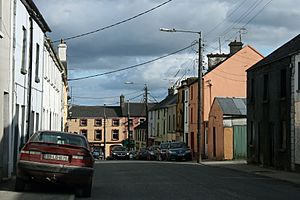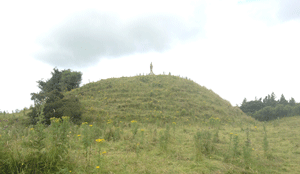Granard facts for kids
Quick facts for kids
Granard
Irish: Gránard
|
|
|---|---|
|
Town
|
|

Market Street
|
|
| Motto(s):
Féile, Flúirse, Fáilte
|
|
| Country | Ireland |
| Province | Leinster |
| County | County Longford |
| Elevation | 82 m (269 ft) |
| Population
(2016)
|
816 |
| Time zone | UTC±0 (WET) |
| • Summer (DST) | UTC+1 (IST) |
| Eircode routing key |
N39
|
| Telephone area code | +353(0)4366 |
| Irish Grid Reference | N324814 |
Granard (pronounced Grah-nard, and called Gránard in Irish) is a town in the north of County Longford, Ireland. Its history can be traced back to at least 236 CE.
Granard is located where two important roads, the N55 and the R194, meet. It sits just south of the dividing line between the areas where water flows into the River Shannon and the River Erne. The town is about 20 kilometers northeast of Longford town. The larger area, known as the barony of Granard, is named after the town.
Contents
Granard's Long History
Granard has been a busy place since ancient Celtic times. Its high position probably made it a good spot to see the surrounding countryside.
Ancient Legends and Early Times
The town is even mentioned in an old Irish story called the Táin Bó Cuailgne. In this epic tale, Queen Medb and her army stopped in Granard on their journey. They were trying to capture a famous bull called the Donn Cuailnge.
The name "Granard" is very old, and its exact meaning in Irish is not fully clear. Writers from the 11th century had to explain it in their texts. An old book called the Lebor na hUidre refers to it as "Gránairud of northern Teathbha, which is Gránard today."
According to the Tripartite Life of Saint Patrick, Saint Patrick chose a man named Guasacht to be the first bishop of Granard. However, this church area did not continue as a separate one for long. The family name Sheridan was first recorded in Granard in the 8th century.
The Motte and Harp Festival
Granard is famous for its motte, a large mound of earth built by a person named Risteárd de Tiúit. This motte stands 166 meters (543 feet) above sea level at the edge of the town. In 1932, a statue of Saint Patrick was placed on the motte. This was to celebrate 1500 years since the saint first came to Ireland.
Because Granard is located near three rivers and Lough Sheelin, it's a great place for trout and other types of fishing. The Gaynors, a Gaelic family, were once the lords of Granard.
Between 1780 and 1787, a large new market house was built in Granard. This helped the town become an even more important market center for the local area. The McCartney family helped pay for its construction.
From 1781 to 1785, Granard hosted an annual Harp festival. This was made possible by James Dungan, a merchant from Granard living in Copenhagen. He had heard about similar festivals in Scotland. Many harp players who won prizes at these festivals later performed at the Belfast Harp Festival in 1792. The festival has been brought back to life since 1981.
Granard During the War of Independence
During the Irish War of Independence, an event happened in Granard. On October 31, 1920, a police officer was shot in a hotel bar. Four days later, a group of Crown forces came into the town. They destroyed some of the main businesses in Granard as a response to the shooting.
Local Government in Granard
Granard's local government has changed over the years. In 1899, it became an "urban district." This meant it had its own local council to manage town affairs.
Later, this council was changed to "town commissioners." In 2002, it became the Granard Town Council. However, in 2014, this local government body was removed. Now, Longford County Council is responsible for the town. Granard also has its own local area, called the Granard Municipal District. This district is represented by five elected councillors.
Getting Around Granard
Granard is close to Edgeworthstown railway station, which is about a fifteen-minute drive away. However, there isn't a direct bus that connects Granard to the train station.
Bus Services
Bus Éireann offers a route (number 65) that goes to Monaghan (where you can connect to Belfast) and to Athlone (where you can connect to Galway). This service runs once a day in each direction, with an extra service on Fridays.
Another Bus Éireann route (number 111A) connects Granard to Cavan and Athboy. From Athboy, you can connect to Trim and Dublin. This bus runs four times a day each way on weekdays, three times on Saturdays, and once on Sundays.
A local bus company, Donnelly's Pioneer Bus Service, also runs a TFI Local Link route. This route goes from Granard to Longford through Ballinalee. It has several trips each way during the week, but no service on Sundays.
Famous People from Granard
Many notable people have connections to Granard:
- Thomas Henry "Tommy" Bond (1856–1941) was a baseball player. He was the first person born in Ireland to play Major League Baseball.
- Larry Cunningham (1938–2012) was an Irish country music singer. He was the first Irish showband artist to have a song on the British music charts in 1964. He was from nearby Clooneen.
- Kitty Kiernan (1892–1945) was born in Granard. She was engaged to the famous Irish revolutionary leader, Michael Collins.
- Ann Lovett (1968–1984) was a schoolgirl from Granard.
- Eddie Macken (born 1949) is an international show jumper. He was born and lived in Granard.
- James O'Brien (1806–1882) was a High Court judge. He was born in Granard.
- Brendan O'Reilly (1929–2001) was an Irish broadcaster and athlete.
- James Bronterre O'Brien was a leader of the Chartist Movement, which worked for political rights for working people.
See also
 In Spanish: Granard para niños
In Spanish: Granard para niños



